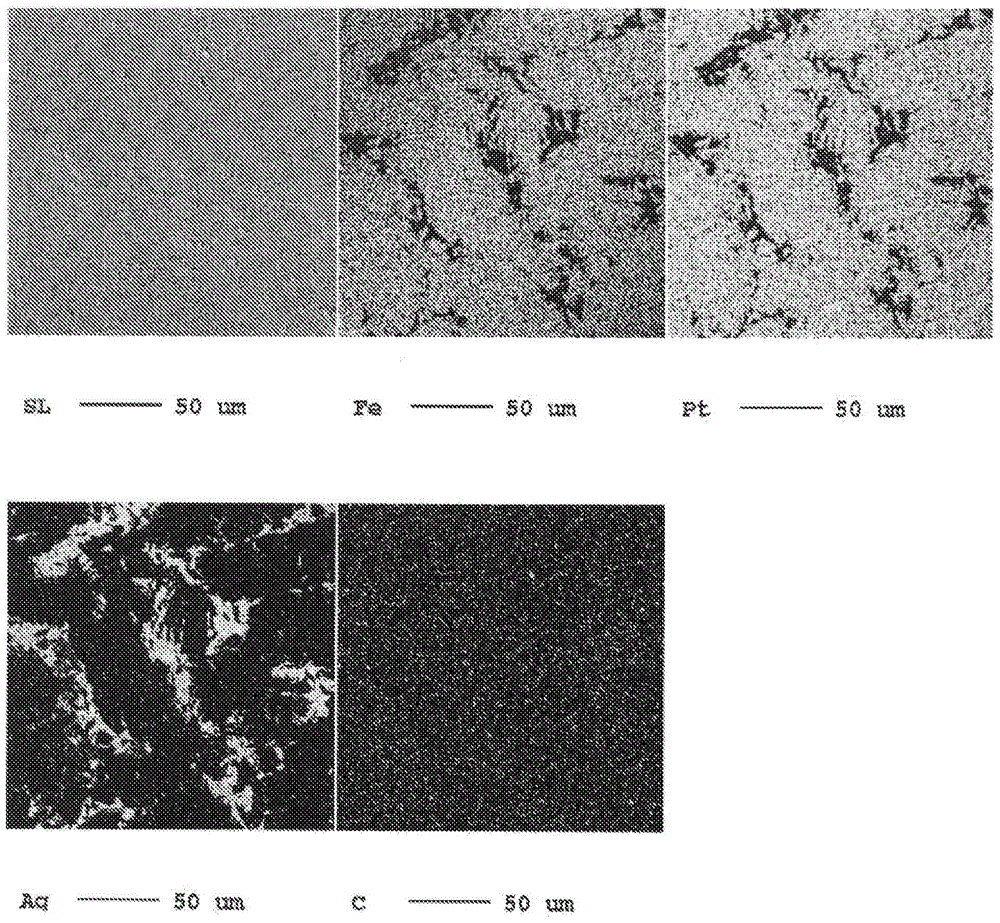fe-pt-ag-c-based sputtering target dispersed with c particles and manufacturing method thereof
一种制造方法、溅射靶的技术,应用在溅射靶领域,能够解决异常放电、难以得到高密度烧结体、无法制造出等问题,达到粉粒量降低的效果
- Summary
- Abstract
- Description
- Claims
- Application Information
AI Technical Summary
Problems solved by technology
Method used
Image
Examples
Embodiment 1
[0073] As raw material powders, Fe powder with an average particle diameter of 3 μm, Pt powder with an average particle diameter of 3 μm, Ag powder with an average particle diameter of 2 μm, and C powder with an average particle diameter of 1 μm were prepared. First, Fe powder, Pt powder, and C powder were weighed in a total weight of 3000 g according to the following atomic number ratio.
[0074] Atomic ratio: (Fe 50 -Pt 50 ) 52.94 -C 47.06
[0075] Next, the weighed powder was enclosed in a ball mill jar with a capacity of 10 liters together with zirconia balls as a grinding medium, and rotated for 4 hours to perform mixing and grinding. Then, the powder taken out of the tank is filled into a carbon mold, molded and sintered using a hot press device. The hot pressing conditions were: vacuum atmosphere, heating rate 300° C. / hour, holding temperature 1400° C., holding time 2 hours, and pressurization at 30 MPa from the start of heating to the end of holding. Cool natural...
Embodiment 2
[0086] As raw material powders, Fe powder with an average particle diameter of 3 μm, Pt powder with an average particle diameter of 3 μm, Ag powder with an average particle diameter of 2 μm, and C powder with an average particle diameter of 1 μm were prepared. First, Fe powder, Pt powder, and C powder were weighed in a total weight of 3000 g according to the following atomic number ratio.
[0087] Atomic ratio: (Fe 50 -Pt 50 ) 56.25 -C 43.75
[0088] Next, the weighed powder was enclosed in a ball mill jar with a capacity of 10 liters together with zirconia balls as a grinding medium, and rotated for 4 hours to perform mixing and grinding. Then, the powder taken out of the tank is filled into a carbon mold, and molded and sintered using a hot press device. The hot pressing conditions were: vacuum atmosphere, heating rate 300° C. / hour, holding temperature 1400° C., holding time 2 hours, and pressurization at 30 MPa from the start of heating to the end of holding. Cool nat...
Embodiment 3
[0105] As raw material powders, Fe powder with an average particle diameter of 3 μm, Pt powder with an average particle diameter of 3 μm, Ag powder with an average particle diameter of 2 μm, and C powder with an average particle diameter of 1 μm were prepared. First, Fe powder, Pt powder, and C powder were weighed in a total weight of 3000 g according to the following atomic number ratio.
[0106] Atomic ratio: (Fe 65 -Pt 35 ) 42.11 -C 57.89
[0107] Next, the weighed powder was enclosed in a 10-liter ball mill jar together with zirconia balls as a grinding medium, and rotated for 4 hours to perform mixing and grinding. Then, the powder taken out of the tank is filled into a carbon mold, and molded and sintered using a hot press device. The hot pressing conditions were: vacuum atmosphere, heating rate 300° C. / hour, holding temperature 1400° C., holding time 2 hours, and pressurization at 30 MPa from the start of heating to the end of holding. Cool naturally in the chambe...
PUM
| Property | Measurement | Unit |
|---|---|---|
| relative density | aaaaa | aaaaa |
| size | aaaaa | aaaaa |
| relative density | aaaaa | aaaaa |
Abstract
Description
Claims
Application Information
 Login to View More
Login to View More - R&D
- Intellectual Property
- Life Sciences
- Materials
- Tech Scout
- Unparalleled Data Quality
- Higher Quality Content
- 60% Fewer Hallucinations
Browse by: Latest US Patents, China's latest patents, Technical Efficacy Thesaurus, Application Domain, Technology Topic, Popular Technical Reports.
© 2025 PatSnap. All rights reserved.Legal|Privacy policy|Modern Slavery Act Transparency Statement|Sitemap|About US| Contact US: help@patsnap.com

